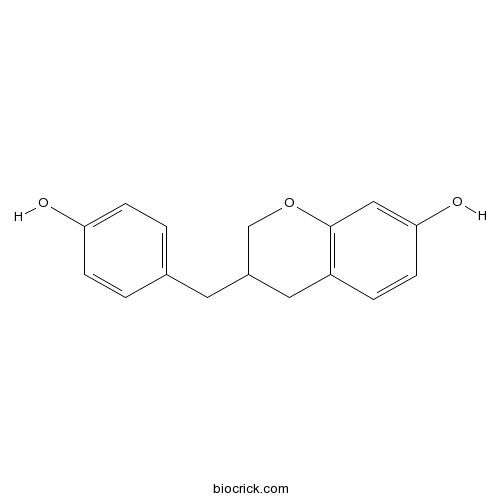7-Hydroxy-3-(4-hydroxybenzyl)chromanCAS# 1180504-64-6 |

Quality Control & MSDS
3D structure
Package In Stock
Number of papers citing our products

| Cas No. | 1180504-64-6 | SDF | Download SDF |
| PubChem ID | 11708657 | Appearance | Powder |
| Formula | C16H16O3 | M.Wt | 256.3 |
| Type of Compound | Flavonoids | Storage | Desiccate at -20°C |
| Solubility | Soluble in Chloroform,Dichloromethane,Ethyl Acetate,DMSO,Acetone,etc. | ||
| Chemical Name | 3-[(4-hydroxyphenyl)methyl]-3,4-dihydro-2H-chromen-7-ol | ||
| SMILES | C1C(COC2=C1C=CC(=C2)O)CC3=CC=C(C=C3)O | ||
| Standard InChIKey | GXMQROMLTBPBKV-UHFFFAOYSA-N | ||
| General tips | For obtaining a higher solubility , please warm the tube at 37 ℃ and shake it in the ultrasonic bath for a while.Stock solution can be stored below -20℃ for several months. We recommend that you prepare and use the solution on the same day. However, if the test schedule requires, the stock solutions can be prepared in advance, and the stock solution must be sealed and stored below -20℃. In general, the stock solution can be kept for several months. Before use, we recommend that you leave the vial at room temperature for at least an hour before opening it. |
||
| About Packaging | 1. The packaging of the product may be reversed during transportation, cause the high purity compounds to adhere to the neck or cap of the vial.Take the vail out of its packaging and shake gently until the compounds fall to the bottom of the vial. 2. For liquid products, please centrifuge at 500xg to gather the liquid to the bottom of the vial. 3. Try to avoid loss or contamination during the experiment. |
||
| Shipping Condition | Packaging according to customer requirements(5mg, 10mg, 20mg and more). Ship via FedEx, DHL, UPS, EMS or other couriers with RT, or blue ice upon request. | ||
| Description | 1. 7-Hydroxy-3-(4-hydroxybenzyl)chroman shows moderate inhibitory activity against a chymotrypsin-like activity of the proteasome. |

7-Hydroxy-3-(4-hydroxybenzyl)chroman Dilution Calculator

7-Hydroxy-3-(4-hydroxybenzyl)chroman Molarity Calculator
| 1 mg | 5 mg | 10 mg | 20 mg | 25 mg | |
| 1 mM | 3.9017 mL | 19.5084 mL | 39.0168 mL | 78.0336 mL | 97.5419 mL |
| 5 mM | 0.7803 mL | 3.9017 mL | 7.8034 mL | 15.6067 mL | 19.5084 mL |
| 10 mM | 0.3902 mL | 1.9508 mL | 3.9017 mL | 7.8034 mL | 9.7542 mL |
| 50 mM | 0.078 mL | 0.3902 mL | 0.7803 mL | 1.5607 mL | 1.9508 mL |
| 100 mM | 0.039 mL | 0.1951 mL | 0.3902 mL | 0.7803 mL | 0.9754 mL |
| * Note: If you are in the process of experiment, it's necessary to make the dilution ratios of the samples. The dilution data above is only for reference. Normally, it's can get a better solubility within lower of Concentrations. | |||||

Calcutta University

University of Minnesota

University of Maryland School of Medicine

University of Illinois at Chicago

The Ohio State University

University of Zurich

Harvard University

Colorado State University

Auburn University

Yale University

Worcester Polytechnic Institute

Washington State University

Stanford University

University of Leipzig

Universidade da Beira Interior

The Institute of Cancer Research

Heidelberg University

University of Amsterdam

University of Auckland

TsingHua University

The University of Michigan

Miami University

DRURY University

Jilin University

Fudan University

Wuhan University

Sun Yat-sen University

Universite de Paris

Deemed University

Auckland University

The University of Tokyo

Korea University
- 4-O-Methylgrifolic acid
Catalog No.:BCN7287
CAS No.:118040-60-1
- Eriodictyol-6-glucoside
Catalog No.:BCN8026
CAS No.:118040-45-2
- PHM 27 (human)
Catalog No.:BCC5869
CAS No.:118025-43-7
- Blumeatin
Catalog No.:BCN6055
CAS No.:118024-26-3
- Limonin
Catalog No.:BCN6057
CAS No.:1180-71-8
- Acetylepipodophyllotoxin
Catalog No.:BCN6056
CAS No.:1180-35-4
- Ortho-Hydroxyacetophenone
Catalog No.:BCN3827
CAS No.:118-93-4
- Maltol
Catalog No.:BCN4819
CAS No.:118-71-8
- Trimethylgallic acid
Catalog No.:BCN3424
CAS No.:118-41-2
- Syringin
Catalog No.:BCN6059
CAS No.:118-34-3
- Cinchonine
Catalog No.:BCN2464
CAS No.:118-10-5
- Hydrastine
Catalog No.:BCC8187
CAS No.:118-08-1
- PS 48
Catalog No.:BCC7859
CAS No.:1180676-32-7
- Dihydroprehelminthosporol
Catalog No.:BCN7288
CAS No.:118069-95-7
- Zoledronic Acid
Catalog No.:BCC1067
CAS No.:118072-93-8
- L-365,260
Catalog No.:BCC7477
CAS No.:118101-09-0
- Prehelminthosporolactone
Catalog No.:BCN7289
CAS No.:118101-72-7
- Cyprodime hydrochloride
Catalog No.:BCC7425
CAS No.:118111-54-9
- Karounidiol
Catalog No.:BCN2704
CAS No.:118117-31-0
- Schisanwilsonin H
Catalog No.:BCN3315
CAS No.:1181216-83-0
- Schisanwilsonin I
Catalog No.:BCN5548
CAS No.:1181216-84-1
- [Phe8Ψ(CH-NH)-Arg9]-Bradykinin
Catalog No.:BCC5995
CAS No.:118122-39-7
- Volvaltrate B
Catalog No.:BCN6736
CAS No.:1181224-13-4
- 6''-O-Acetylastragalin
Catalog No.:BCN6058
CAS No.:118169-27-0
7-hydroxy-3-(4-hydroxybenzyl)chroman and broussonin b: neurotrophic compounds, isolated from Anemarrhena asphodeloides BUNGE, function as proteasome inhibitors.[Pubmed:16141565]
Biol Pharm Bull. 2005 Sep;28(9):1798-800.
The extract of Anemarrhenae Rhizoma (rhizomes of Anemarrhena asphodeloides BUNGE) showed neurotrophic activity toward rat pheochromocytoma (PC-12) cells. Bioassay-guided purification afforded four compounds, 2,6,4'-trihydroxy-4-methoxybenzophenone (1), 7-Hydroxy-3-(4-hydroxybenzyl)chroman (2), broussonin B (3), and cis-hinokiresinol (4). Compounds 1-3 induced neurite outgrowth in PC-12 cells at concentration of 50 microg/ml, while 4 was less active. In addition, compounds 2-4 showed moderate inhibitory activities against a chymotrypsin-like activity of the proteasome.


